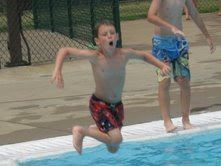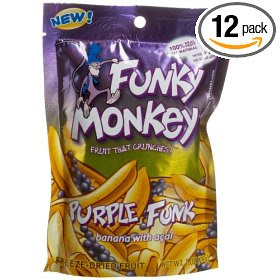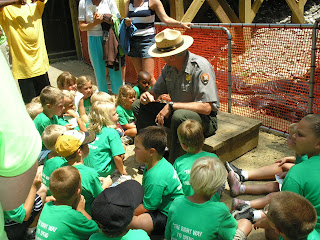
baltimoresun.com
The next big thing: smaller schools
In Baltimore County, add-ons losing support
By Liz Bowie
Sun reporter
June 22, 2008
Comment: All I can say is duh. But I can add that smaller must begin with Early Childhood. These huge warehouses that house 200-300 little kids are a hazard to the developing child.
Across the nation, urban school districts are breaking up large schools and replacing them with smaller ones. In Baltimore, new high schools with as few as 400 to 500 students have been carved out of old ones with enrollments of 2,000 or more.
Now support for small schools appears to be taking root – at the neighborhood level and the school board – in neighboring Baltimore County, which like many suburban districts has long favored large schools.
Vocal parents upset about crowding in the Towson area and elsewhere have demanded new, smaller schools rather than additions to existing ones. Sparked by those complaints, the school board recently reversed course and withdrew a proposal to expand Loch Raven High School; the county has also agreed to build a new 400-seat elementary school in the Towson area rather than expand a school.
The school board, meanwhile, is taking a closer look at research on school size.
“The current board, I think, believes that an overly large school presents problems,” said JoAnn C. Murphy, president of the county school board.
County Executive James T. Smith Jr., who supported building additions at two schools this spring rather than new schools, said in an interview that he has never had a conversation about school size with the county’s school superintendent. He also said he has no opinion on optimum size for schools, though he believes schools with 2,000 students are too large.
Over the past decade, the county has added additions of 400 to 600 seats to seven high schools, turning several into schools of 2,000 students or more. This fall, Vincent Farm Elementary will open in the northeast part of the county with a capacity of 700 students, much larger than an average elementary school.
Achievement
The switch to smaller schools by urban school districts is supported by research indicating that they might boost student achievement.
Craig Howley, an Ohio University researcher and a proponent of small schools, said “a suburban community that is building high schools over 1,000 is making a mistake.” Achievement “degrades” for all students at schools with enrollments exceeding 900, he maintains.
Just how big a school should be has been debated for the past half-century when the first proponents of large high schools extolled their cost effectiveness, large course offerings and opportunities for sports and extracurricular activities. Schools for as many as 3,000 and 4,000 students were built in the 1970s across the nation.
But many urban districts began rethinking that strategy, particularly when graduation rates dropped, violence and fighting rose, and achievement declined. These problems prompted some educators to conclude that large urban schools were unmanageable.
Even suburban districts began to question whether bigger was really better after the killings at Columbine High School, a large suburban school in Colorado. The size of the school was a contributing factor because students did not feel as close a connection to their teachers and other students, according to one report.
Current educational research suggests small schools might be more beneficial to students. The optimum size for a high school is 600 to 900 students, according to a study published in Educational Evaluation and Policy Analysis in 1997.
“We did find that the ideal size of a school did not vary by the social or racial composition of the school. However, small size was more strongly linked to achievement gains in more disadvantaged schools,” said Valerie Lee, a University of Michigan professor and one of the authors of the report.
Other studies have shown that students in small schools are more likely to be better known by their teachers and go to college.
‘Personalization’
New York, Chicago and Baltimore are just a few of the cities that have created small schools. Michigan is offering $3 million in state money to any school that wants to downsize or create new small schools of 400. To be eligible a school must have a graduation rate below 70 percent and the school must return 50 percent of the money if the school doesn’t graduate at least 80 percent of its students.
“I think there is a certain weight of evidence that has developed around the country,” said Chuck Wilbur, the education adviser to Michigan Gov. Jennifer M. Granholm.
The Bill and Melinda Gates Foundation, over the course of the past decade, has donated more than $1 billion to cut up large urban high schools under the belief that students would perform better in smaller schools.
The foundation donated $12 million in Baltimore to break up existing high schools, and local foundations added $8 million more.
While results have been mixed at schools that were broken up, a recent study by the Urban Institute, a Washington think tank, showed that the newly created innovation high schools in Baltimore with 400 to 500 students have better graduation rates than other high schools in the city, with the exception of the elite schools.
Moreover, in two of the “innovation” high schools that graduated their first classes this spring, more than 85 percent of students had been accepted at a college, the majority of them four-year institutions. In Baltimore about 44 percent of graduates go on to college.
“I think that the size of a school matters. You can have strong large schools, but in schools that face challenges, personalization matters a great deal,” said city schools chief, Andres Alonso.
There are still those who support large high schools and say that they can point to any number of top high schools in the county that are quite large. High-achieving students, they say, will have a larger selection of Advanced Placement and honors classes in a big school.
One of Prince George’s County’s premier high schools is Eleanor Roosevelt, which now has 3,700 students.
And a number of top Montgomery County high schools are nearly as large.
But Howard County and Anne Arundel County high schools are smaller. In Anne Arundel, the enrollment is between 1,200 and 1,600. Howard County, another county that has grown rapidly, has decided to limit the size of its high schools to 1,400 students but is building elementary schools of 700.
“Success is not directly related to size,” argues David Lever, executive director of the state’s Interagency Committee on School Construction. “I think the more important factor is how the school is managed.”
But many educators say that it is more difficult to manage very large schools.
Troubled school
One of Baltimore County’s expansion projects was a 600-seat addition to Woodlawn High School, now the district’s most troubled high school.
At Woodlawn only 25 percent of students passed the biology high school assessment last year and only 37 percent passed English II. Those pass rates are below those of some of the new small high schools in Baltimore.
Smith, the county executive, said he would support the breakup of Woodlawn into two schools with separate staffs operating out of one building. But he does not think that the county has the money to build a new small high school on a different site to downsize Woodlawn.
Gene Bottoms, the senior vice president of the Southern Regional Education Board, said that simply breaking up failing high schools does not necessarily improve the teaching.
But, he said, all things being equal, students in smaller schools are likely to be more involved in extracurricular activities and to have closer ties to their schools that result in higher achievement.
One of the problems with large high schools, Bottoms said, is that students tend to be segregated in different tracks.
The best schools are known for their top students, he said, but the success of the top 25 percent masks what is happening to the bottom 25 percent.
“It is much easier to sort students into pigeonholes and create low expectations for some students,” he said.
Meg O’Hare, a county school board member, said sometimes parents have been happy to get additions to their schools because the alternative was trailers next to the schools. But rarely are the core facilities – the gym, cafeteria and hallways – expanded to handle the extra students. The result, she said, is still too many students in the facilities.
Often, she said, the school board supported building a new school, but county executives have decided to allocate money for an addition instead.
“Things come into our budget that we didn’t put there. We always rolled over,” O’Hare said. “The school board is starting to stand up to the responsibility for adequate facilities for the public schools.”
She said the Loch Raven vote was the board saying: “Enough.” The county executive contends that decisions about school size are made by the school board.
The problem of crowding in the northeastern portion of the county remains. Five high schools – including Towson, Hereford, Loch Raven, Perry Hall and Patapsco – have an enrollment that is 10 percent above the school’s capacity. The county executive’s office contends that that is not enough to warrant building a new school.









